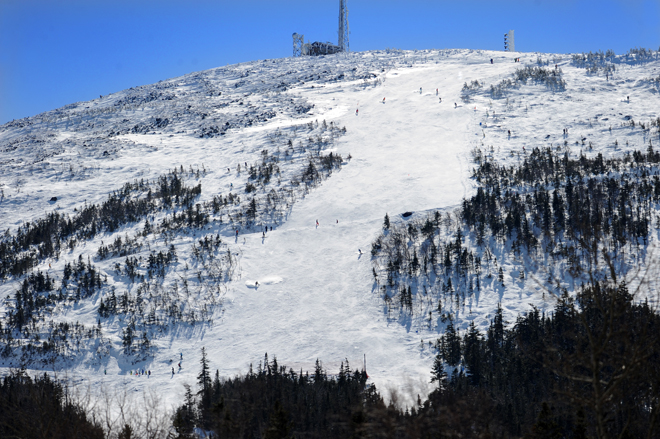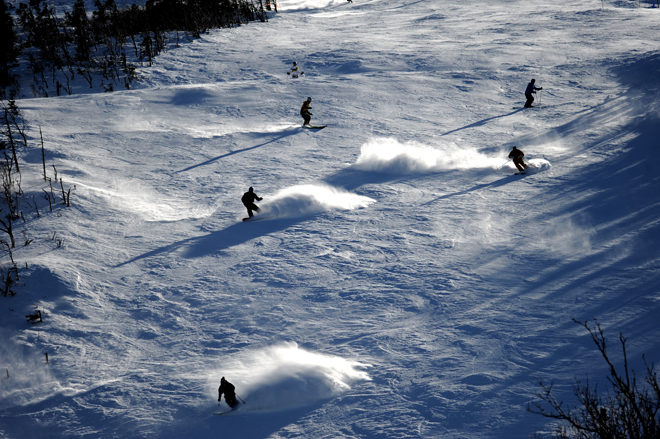The Magic Mountain
FEATURE-December 2013
By Jaed Coffin
Photographs by Fred Field
Letting go at Sugarloaf
Last Easter, I spent the weekend at Sugarloaf with my wife and four-year-old daughter. It was that time of year when, after a long and somewhat housebound winter, we all needed to feel like we were still alive. Also, I figured it was time that my daughter took the next step forward in her Maine winter education. We’d built snowmen and igloos and gone sledding. I’d even pulled her around the backyard in an old canoe. But the fact of her growing up and needing to…evolve?…was as obvious and striking to me as the bright white stripes coming down the mountain as we turned onto Sugarloaf Access Road that Friday night.
The next morning about 9 a.m., I brought my daughter to the ground floor of the base lodge and checked her in for a Mountain Magic lesson at the Sugarloaf ski school. There was something bittersweet about watching her wander into a room full of plastic boots and skis and poles and then hobble into a line of similarly adorned children, all of whom were wearing helmets.
Helmets? As in: she might fall? As in: I’m willfully allowing her to do something…dangerous? That I had gone through this ritual myself, almost three decades earlier, had no bearing on the present.
Elise Burgess, who drives north four and half hours from Massachusetts every Friday so that she and her family can spend their weekends at the mountain, must have seen my type before. She greeted us warmly then checked us in.
“Every weekend? From Massachusetts?” I said, impressed but also kind of baffled. As a kid, even from Brunswick, I always felt as though the drive north—along the quiet turns of Route 27, through Belgrade and Farmington and Kingfield—seemed like a journey to a different Maine planet.
Elise smiled. “We’re pretty committed,” she said. Her husband, Winston, volunteers with the Maine adaptive skiing program. Her daughters, Kate and River, 16 and 17, teach at Mountain Magic. “When we’re not working,” she told me, “we ski.”
Then Elise clicked open a rope, let my daughter pass through, and closed the rope behind her. “It’s a little easier when the parents stay back,” she said.
I nodded, solemnly, and watched my daughter fade into the crowd of the nearly 100 other children who come through this program every weekend. I called out “Goodbye!” but she was already gone.
Even though I had nearly three hours to ski on my own—a luxury that I haven’t allowed myself in years—I couldn’t stay away. I tried, I swear. I stomped upstairs, even lifted my skis off the rack, but I had to turn around.
On the side of a sunny and very moderate slope, I stood with a handful of other parents as a dozen bundled versions of my daughter zigzagged past me. Some of them made it to the bottom of the hill, and were riding the Moosecalator—a conveyer belt-like device—some 100 yards back to the top. Others were not so lucky, but were still trying. In the spring weather, the slushy slope, dappled with kids and parents and wind-burned teenage instructors, reminded me of a white-sanded beach scene.
While searching for my daughter’s red snowsuit, I chatted with some of the other dads—pretending to make small talk but really looking for support. Adam Richards, of Windham, was helping his daughter, Mila, one and a half, wobble downhill. She typically wore kids’ size two shoes, but that morning, because Richards couldn’t find anything smaller, she was wearing size nine boots that were so big that several times they just dropped off her feet. This was Mila’s third run.
“Got to get her out early,” Richards said. “Start young, she’ll love it forever.” Richards’s wife, Courtney, who was taking pictures several yards uphill, didn’t seem so eager.
Richards shrugged. “In a few years, I’ll be able to rip with her.”
Brett Austin, of Portland, was skiing alongside his daughter, Maeve, and son, Kaegan. “To me, it’s about getting outside,” he said. “Life is so busy. Time on a chairlift, taking runs together, hanging out at night, there are just so many teaching moments you don’t get at home.”
Then a snowmobile that looked like a moose—I later found out it was called the Moose Caboose—zipped by, roaring uphill with a pack of smiling kids. The machine looked like it had come straight off the set of Willy Wonka and the Chocolate Factory. The kids loved it.
Then I saw her: stumbling through a lesson with Nicole Pineau, 16, from Portland. A junior at Cheverus High School, Pineau spends every weekend of the winter at Sugarloaf. She has the vibrance and good cheer of a Sesame Street actress, and as I watched my daughter cautiously link her first very slow turns, and as I watched Pineau ski backwards while guiding her forward, it was hard not to feel a little bit lucky, and even grateful.
The night before, while checking into our condo, I’d chatted with Matt Boehmer—a young man from Bangor who had been living in Kingfield and working at Sugarloaf for the last two years. When he’d asked me what brought me to Sugarloaf, I’d told him that I was up here for my daughter’s sake, but mentioned that I might get a chance to go off on my own for a few hours—just like I used to back when I was his age. Boehmer understood the subtext of my plea, and slipped me his cell number.
“I’ll be on the mountain all day,” he said. “Give me a call and I’ll show you around.”
About midway up the chairlift, I gave Boehmer a call. He answered, but all I could hear was “King Pine.” Twenty minutes later, I was following him, skis on our shoulders, up a steep glade under the summit. We were still in bounds, but headed for an area that hadn’t seen much traffic that day. There was a rock that Boehmer wanted to show me, where, if you hit it right, you could clear all the danger underneath it—trees, more rocks, ice—and land in a pocket of powder. We spent the next hour hiking above the rock, hitting it, crashing, and then hiking up again. While resting, I asked him how he’d found himself making a life around the mountain.
“I was at UMaine,” Boehmer said, “but I just wasn’t happy.” After Boehmer talked with his brother—who lived in Kingfield—about how he was feeling, his brother had just three words of advice: “Get up here.”
“I still don’t know what I want to do with my life,” Boehmer said. “But this year has been amazing. It’s the people. Awesome people. Greatest people I’ve ever known.”
After another hour or so of acting like 15 year olds—at one point, we decided to hit the rock shirtless—I told him I had to get back down to my daughter’s lesson. We shook hands and I let him have the summit to himself.
The lesson went well—as in, when I asked my daughter if she wanted another one on Sunday, she said, very sternly, “Yes, Dad.”
That night, my wife and daughter and I ate dinner at the Rack. It’s the kind of place for young and old, crazy and tame. A band was warming up on the stage, a March Madness tournament game was on the TV, a girl was walking around with a puppy in her arms. On the deck out front, people were drinking beer and staring up at the mountain and talking about their day. After a few rounds of Air Hockey, it was bedtime.
While my wife and daughter slept, I went up to Widowmaker, where Nicki Bluhm and the Gramblers, a band that earned its fame by posting Youtube videos of themselves performing in a moving van, was getting warmed up.
At one table, I met up with Lucas Richie, from Houlton, and his wife. Newlyweds, they came up from Portland for the night, just to get out of town. A few tables away, Jennifer Frost and Michelle Ayotte, from Winslow, were bouncing their heads to the music. “Friends since the sandbox,” they referred to themselves as “Sugarloaf believers.”
“This is the Disneyland of Maine,” Frost said. “It’s Chuck E. Cheese for adults. People sometimes say ‘Maine sucks, it’s too cold!’ but you just got to get off the friggin’ couch! I hear of people getting seasonal depression and all that, but I say get over it and get up here.”
Ayotte felt the same. “I’m a total Sugarloaf snob,” Ayotte said. Tomorrow, Ayotte and Frost had big plans: they were going to hit the slopes with bunny ears and cottontails.
The next morning, I brought my daughter up to the base lodge for another Mountain Magic session with Nicole Pineau. By now, my daughter had all but adopted Pineau as her big sister.
As for me, I’d adjusted my expectations: I really didn’t care if my daughter learned how to ski; all I wanted was to know that she was having a good time, with a cool older girl who valued things that I felt were important: fresh air, respect for the winter, and the ability to fail and get back up again.
My wife and I took several runs. When we got back to the slope, we were worried: no sign of the red snowsuit. Then the Moose Caboose zipped past us, my daughter waving, cuddled up next to her new buddy. The Moose Caboose climbed several hundred yards above the base lodge, and then a bit higher.
“No way,” I said to my wife.
“No way,” my wife said back.
Then we watched my daughter, mimicking Pineau’s every move, cut about 30 turns—big, relentless, fearless, reckless turns. As she passed us, she smiled, laughed proudly, and then tumbled into a bank of slush.
I couldn’t believe it. Really, I couldn’t believe it. And later that afternoon, as I sat on the deck of the base lodge drinking a beer and watching my wife and daughter dance in their ski boots to Gangnam Style—Happy Easter!—with a bunch of other kids, I still couldn’t believe it.






























